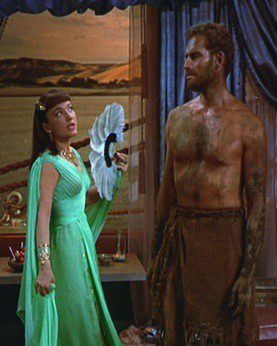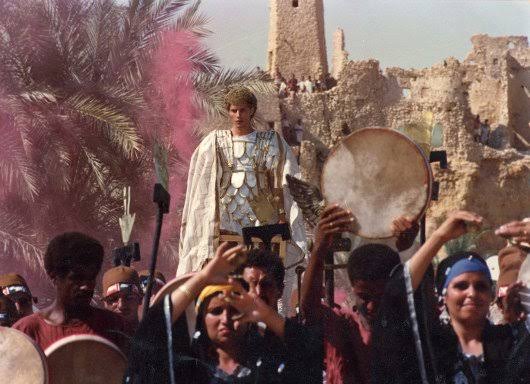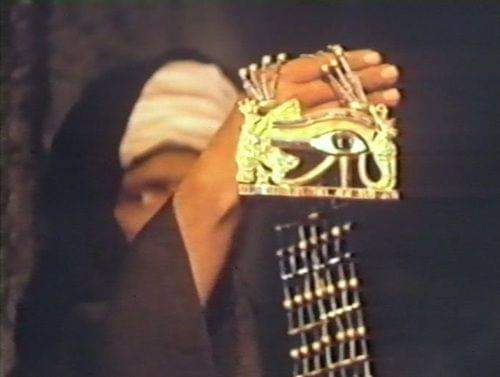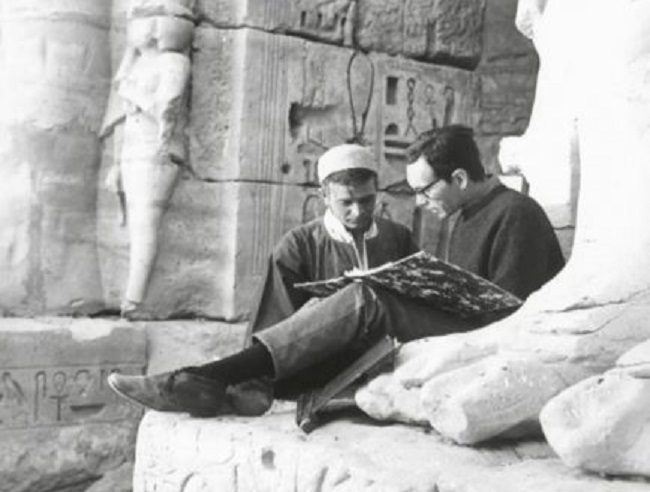Egypt on Screen
“This is about as majestic as it gets…”
Morgan Freeman and Jack Nicholson at the pyramids in Giza reflecting on life, a classic scene from The Bucket List (2007) https://www.youtube.com/watch?v=utAOfNfI_vE
This scene was actually filmed in Egypt, unlike many movies that are set in Egypt but which were filmed in locations in other countries or in studios.
Although there are countless Egypt themed movies not filmed here, fortunately many others were and can give you a sense of what you may see when you visit Egypt.
Eleanor Parker and Robert Taylor filmed Valley of the Kings in Egypt. It was released in 1954, the same year Omar Sharif and Faten Hamama starred in Sira` Fi al-Wadi / Struggle in the Valley (The Blazing Sun).


PHOTO DISCLAIMER:
Photographs are not credited as they are drawn from various film sources across the internet, each has multiple sources which makes it impossible to be sure of the original source.
No copyright infringement is intended.
Omar Sharif and Faten Hamama in Luxor, in
Sira`Fi al-Wadi / Struggle in the Valley (The Blazing Sun)
Director Youssef Chahine chose one of Luxor’s ancient architectural wonders as the set for the most dramatic action.
Omar Sharif plays Ahmed, an engineer whose father is a farmer and a farm owner. His father succeeds in improving and increasing the production of sugar cane in his farm. Taher Pasha, a wealthy landowner who runs a competing sugar cane production facility, feels threatened by his recent prosperity. Ahmed is in love with the pasha’s daughter Amal, but because of rivalry between their fathers, he is compelled to hide their relationship.Themes are related to the political and social events in Egypt since 1952 (Chahine never makes a purely romantic film, there are always socio-political nuances).




scenes and the brick pit costumes from The Ten Commandments
The Ten Commandments (1956) was shot in Hollywood and on location in Egypt. The company traveled from their headquarters at Giza to Fayoum to shoot the brick pits sequence. A page from the film’s wardrobe plot book shows Charlton Heston (Moses) appearing as a slave in Arnold Friberg’s costume design. According to documents in the Paramount Pictures production records, thousands of extras were also outfitted for the brick pits sequence. The supervising costume designer on location in Egypt, Dorothy Jeakins, called for “enough fabric yardage [to be] purchased, dyed and aged in Cairo to provide 2,150 loincloths for the men, and 800 simple, workable, functional garments for the women and 100 children (50 boys, 50 girls).” She also mandated that the “dying should be rich, ruddy colors to contrast with the elephant color of the mud and the dark skin tones of the slaves. If suitable ties or tapes are provided attached to each loincloth, no additional belt need be issued.” The meticulous work of the designers, as well as the legions of assistants in the wardrobe department, earned the film an Academy Award nomination for Costume Design (Color). https://theacademy.tumblr.com/post/84141844826/dressing-the-ten-commandments
Trailer: https://youtu.be/KBzbyIPWVT4
Death on the Nile written by Agatha Christie (1937) has several film and TV series adaptations which give you a taste of sailing along the Nile as it was done in the past. It is interesting to compare the different versions, and how each director chose to present Egypt.
In the 1978 film directed by John Guillermin and adapted by Anthony Shaffer, Belgian detective Hercule Poirot was played by Peter Ustinov, with an all-star supporting cast including Maggie Smith, Angela Lansbury, Bette Davis, Mia Farrow, Jane Birkin, David Niven, George Kennedy, and Jack Warden. The action takes place in Egypt in 1937, mostly on a paddle steamer on the Nile (the SS Sudan, which is named SS Karnak in the film).


Various famous ancient Egyptian sites are featured including the pyramids at Giza and temples at Abu Simbel and Karnak, sometimes out of sequence. The boat starts at Aswan, travels to Karnak and then to Abu Simbel, but if you look at our Itineraries you will see this is not how tours run. Despite this inaccuracy, the acting and costumes are impressive and the film won the award for Best Costume Design at the 51st Academy Awards.
The Spy Who Loved Me (1977) with Roger Moore as James Bond was filmed at locations including Cairo and Luxor (and in Costa Smeralda, Sardinia, with underwater scenes filmed in the Bahamas). It is typical of the Bond movies, including high drama, inventive technology, glamor, danger, romance, and fabulous settings for the action which Egypt naturally provided. Formal evening attire following James Bond style is not recommended for visits to the temples, we suggest our guests dress for comfort instead.
Trailer: https://youtu.be/UBxG_TJvYTg
Love in Karnak / Gharam Fi Al-Karnak (1967) combined stage sets and the actual temples in Luxor as backdrops for music and dance routines. This is the fictionalized story of the Reda troupe, a professional folkloric dance troupe. Costumes include contemporary styles of 1960s Egypt, folk costumes used in dance performances, and some faux ancient Egyptian.
In Arabic, but those who don’t speak Arabic but are interested in Egypt generally could enjoy this to see the temples and other locations in Cairo and Luxor in the late 1960s.
Hatshepsut tribute: juxtaposition of hip 60s dancers and the ancient mortuary temple https://youtu.be/AYOD7fbcJBY
Luxor Baladna: horse carriage ride through the city https://youtu.be/KwT_rpeloxA?si=l4_J4HVcR9U_CaQg
Full film:
https://youtu.be/qku_E4nbfAY?si=-ArXgPixGgFrkTig
Cairo Time (2009) was filmed in Cairo, Alexandria, and the White Desert. Juliette (Patricia Clarkson), a magazine editor, travels to Cairo to meet her husband, Mark (Tom McCamus), a UN official working in Gaza, for a three week vacation. When he is unavoidably delayed, he sends his friend Tareq (Alexander Siddig), who had been his security officer for many years, to escort her around the city. This leads Juliette to an unanticipated attachment to Egypt, and to an
emotional betrayal when she visits the pyramids at Giza with Tareq instead of with her husband.
Trailer: https://youtu.be/orXcdLwtVRY
Interesting article: Female Sensuality And Sensual Cinema In Ruba Nadda’s ‘Cairo Time’
https://screenspeck.com/2022/03/11/sensuality-cairo-time/
Egyptian film director Youssef Chahine was mostly preoccupied with 20th century events, but some of his films included historical figures. Alexander the Great is portrayed in Eskendria Kaman w Kaman / Alexandria Again and Forever (1989), one of Chahine’s autobiographical Alexandria series. A story from the Bible set in Egypt was the inspiration for Al Mohager / The Emigrant (1994). Each film includes various Egyptian locations, and both have been running on Netflix recently with English subtitles.

Chahine filmed Alexander’s visit to Siwa and the temple of the Oracle of Amoun in the actual oasis, and it can’t have been an easy task settling all the cast and crew on the far side of the Western Desert. The scenes at the temple and at Ain Guba, a large spring water pool erroneously known as Cleopatra Spring, are a fanciful telling of this episode in Alexander’s life. Costumes range from borrowing elements of traditional Siwa dress, to pseudo Greek, to men dressed in bat-like leather outfits. Anyone visiting Siwa will recognize the settings including the spring pool, temple remains, and the distinctive earth built homes in the older areas of the town.

scene in Siwa Oasis, in The Emigrant
Al-Mohager / The Emigrant was loosely based on the story of the Biblical Joseph, with Khaled El Nabawy as the Joseph figure and Yusra as an Egyptian queen. Despite the names of the characters being changed by Chahine and removal from the story of all supernatural and miraculous elements, the film raised protests because Islam forbids the visual representation of religious figures. Some scenes are set in an imagined Egyptian palace and temple, with the costumes referencing dress and adornment as shown in ancient Egyptian art and the surviving examples of garments and jewelry you can see in museums. Other scenes were filmed in various locations including Luxor and Siwa Oasis, at least one Siwa man recalls being a child extra in the film.
Faraon / Pharaoh (1966) directed by Jerzy Kawalerowicz and adapted from the novel by Bolesław Prus, is a fascinating film. Kawalerowicz chose the novel because “There are brilliant things in it…. The drama of power in Pharaoh is incredibly topical and contemporary. The mechanics don’t change all that much.”
Watch especially for the contributions of outstanding Egyptian director, screenwriter, costume and set designer Shadi Abdel Salam, who for this film was historical consultant and supervisor of the decoration, costumes and accessories.
He brought a unique vision of Egypt to many films, “I think that the people of my country are ignorant of our history and I feel that it is my mission to make them know some of it and let the others go on with the rest. I regard cinema not as a consumerist art, but as a historical document for next generations.”
In 1967 Faraon was nominated for an Academy Award for Best Foreign Language Film. It sold more than 7 million tickets in Poland, becoming one of the highest-grossing Polish films of all time. It is among 21 digitally restored classic Polish films chosen for the series “Martin Scorsese Presents: Masterpieces of Polish Cinema”.
Trailer: https://youtu.be/-YQTSJJNxD8?si=tGm9t0utAukV9pmu


Shadi Abdel Salam designed the decorations and costumes of some of the most famous historical Egyptian films, including Wa Islamah, Al Nasser Salah Ad-Din, Almaz wa Abdu El Hamouly.
He directed the film The Night of Counting the Years / Al-Momiaa (1969), based on the discovery of 40 royal mummies in 1881 in Luxor, after archaeologists from the Antiquities Department in Cairo noticed that objects bearing royal names from the 21st dynasty were appearing on the black market.
Full movie, subtitles in English and Spanish: https://www.youtube.com/watch?v=jK9uC-fO2rQ


actor with director designer Shady Abdel Salam, and detail from El-Momya / The Night of Counting the Years
To see more of Egypt in his films:
Al Fallah al Fasih / The Eloquent Peasant (1970) short film based on the tale of The Eloquent Peasant which dates to the Middle Kingdom (c. 2040 – 1782 BCE). https://youtu.be/76HgCjDoqvg?si=P-cbPX5iK69SL4oR
Afaq (1973) a documentary which reflected cultural life in modern Egypt.
Goyoush Al Shams (1975) a documentary that tried to capture the fresh sense of triumph in the eyes of the Egyptian soldiers after the 1973 war with Israel.
Korssy Tout Ankh Amun Al Zahaby (1982) Al Ahramat Wama Kablaha (1984)
Ann Ramses Al Thany (1986) – docudramas aimed at spreading awareness of ancient Egyptian heritage.
A film that may have shown us more of Egypt from his unique perspective was The Tragedy of the Great House, also known as Ikhnatoun (Akhenaten). This was to be a historical epic on the reign of Akhenaton. Unfortunately the film was not completed as he insisted on Egyptian funding; he repeatedly rejected offers from foreign sources, insisting that a film on Egyptian history be made exclusively with Egyptian money. He worked on this project for 10 years but never decided on a final version of the film, although most of the decorations, scenes, and costumes were completed before his death.

from the series Secrets of the Nile / Grand Hotel
originally made for Ramadan screening, later on Netflix
TV and streaming series set in Egypt
Egyptian TV and streaming network series are often a feast for the eyes of armchair travelers or anyone dreaming of visiting Egypt. Each year for the holy month of Ramadan, many TV series are made, each of 30 episodes. Egyptians watch the new episodes each evening with family and friends, and many become devoted to particular series. Some series set in previous eras are directed with great attention to details as well as having addictive plots…the best series have their audience looking forward to the new episode the next evening.
With the growth of streaming services such as Netflix, these series with subtitles in English now reach a wider audience. Those who don’t speak Arabic can now enjoy nuances of the plots and witty dialogue, in addition to enjoying the scenery. While some series are still only online in Arabic, expect to see more with subtitles in the future as the international audience for these high quality series continues to grow.
Here are some examples from recent years that feature Egyptian locations, where the location becomes part of the plot and almost a character in the series.
Secrets of the Nile / Grand Hotel (2018)
Moving through the 1950s in Aswan, the action is mostly at the Old Cataract Hotel where our visitors can still stay today. Based on the Spanish series “Grand Hotel”, the Egyptian version has different elements in the plot as well as the attraction of its distinct location on the Nile. The series features some of Egypt’s finest actors and both the ensemble and individual acting is stronger than in the Spanish series. The villains in the Egyptian series are especially evil, while with the characters we are sympathetic to we experience some heartbreaking moments as the mystery unfolds. As with many Egyptian series set in another decade or century, you can feel as though you are stepping directly into Egypt of that era.
Trailer: https://youtu.be/vwAr8X9H6gQ?si=OeT8pVT1cPcyAVaK
Example episode: https://youtu.be/WnFgKLDiqQo?si=eVSSWjQsZjNyIqiF
Aho Da Elly Saar / Once Upon A Time (2019)
Set in Alexandria and Cairo, this series moves between double storylines: the actors play characters in the 21st century that are linked to, but whose destinies are different from, the lives of their characters in the 20th century. Interwoven with their personal dramas are reflections on the changing value of heritage, a timely theme given the destruction of historically significant buildings in Alexandria, Cairo and Luxor during the last decade.
Trailer: https://elcinema.com/en/work/2049443/video/1012627/
Example episode: https://youtu.be/lIKCTINTgcs?si=RBMhO_veVtR0VeGo

promotion for Aho Da Elly Saar / Once Upon A Time
Layali Eugenie / Eugene Nights (2018) steps beyond the more usual big city locations of Cairo and Alexandria. A young woman who believes she has killed her abusive husband flees to Port Said, heartbroken at leaving her young daughter behind with her husband’s family. A nightclub and the neighborhood where she works and lives are the backdrop for emotional dramas and changing fortunes of the characters. Port Said is evoked so strongly that the series may inspire you to add this city to your tour plans for Egypt, although life there has naturally changed since the time in which Eugene Nights is set.
Trailer: https://youtu.be/rclpJDleaeo?si=um0UvYo987wSBBv8
Example episode: https://youtu.be/bCOV_Tvtyn4?si=8SuAoNuLo1h-HCdG
Sunset Oasis / Wahet al Ghoroub (2017) is an adaptation of Bahaa Taher’s award winning novel set in Alexandria and in Siwa Oasis in the late nineteenth century, a time marked by the British colonization of Egypt and the failure of Ahmed Orabi’s revolution.The central characters are an Irish woman who is married to an Egyptian police officer banished to the Oasis, and a young Siwi woman who chafes against the traditions of her society. The series ties the Siwa landscapes and significant archaeological sites to the emotions of the women. Although the culture of the oasis has changed substantially in the last century, locations in the series will feel familiar to anyone who visits Siwa.
Trailer: https://youtu.be/DhKYOHTMLWU
Example episode: https://youtu.be/7VB9ExGltQM?si=GNNd5SbSsIWMczVP






